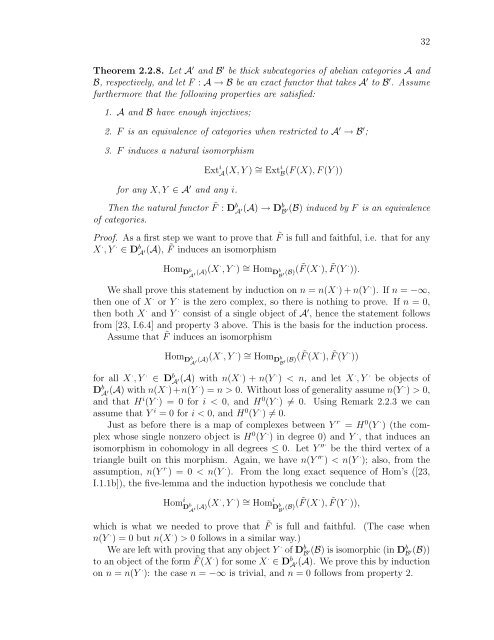derived categories of twisted sheaves on calabi-yau manifolds
derived categories of twisted sheaves on calabi-yau manifolds
derived categories of twisted sheaves on calabi-yau manifolds
Create successful ePaper yourself
Turn your PDF publications into a flip-book with our unique Google optimized e-Paper software.
Theorem 2.2.8. Let A ′ and B ′ be thick sub<str<strong>on</strong>g>categories</str<strong>on</strong>g> <str<strong>on</strong>g>of</str<strong>on</strong>g> abelian <str<strong>on</strong>g>categories</str<strong>on</strong>g> A and<br />
B, respectively, and let F : A → B be an exact functor that takes A ′ to B ′ . Assume<br />
furthermore that the following properties are satisfied:<br />
1. A and B have enough injectives;<br />
2. F is an equivalence <str<strong>on</strong>g>of</str<strong>on</strong>g> <str<strong>on</strong>g>categories</str<strong>on</strong>g> when restricted to A ′ → B ′ ;<br />
3. F induces a natural isomorphism<br />
for any X, Y ∈ A ′ and any i.<br />
Ext i<br />
A(X, Y ) ∼ = Ext i<br />
B(F (X), F (Y ))<br />
Then the natural functor ˜ F : Db A ′(A) → DbB ′(B) induced by F is an equivalence<br />
<str<strong>on</strong>g>of</str<strong>on</strong>g> <str<strong>on</strong>g>categories</str<strong>on</strong>g>.<br />
Pro<str<strong>on</strong>g>of</str<strong>on</strong>g>. As a first step we want to prove that ˜ F is full and faithful, i.e. that for any<br />
X · , Y · ∈ D b A ′(A), ˜ F induces an isomorphism<br />
Hom D b<br />
A ′(A)(X · , Y · ) ∼ = Hom D b<br />
B ′(B)( ˜ F (X · ), ˜ F (Y · )).<br />
We shall prove this statement by inducti<strong>on</strong> <strong>on</strong> n = n(X · ) + n(Y · ). If n = −∞,<br />
then <strong>on</strong>e <str<strong>on</strong>g>of</str<strong>on</strong>g> X · or Y · is the zero complex, so there is nothing to prove. If n = 0,<br />
then both X · and Y · c<strong>on</strong>sist <str<strong>on</strong>g>of</str<strong>on</strong>g> a single object <str<strong>on</strong>g>of</str<strong>on</strong>g> A ′ , hence the statement follows<br />
from [23, I.6.4] and property 3 above. This is the basis for the inducti<strong>on</strong> process.<br />
Assume that ˜ F induces an isomorphism<br />
Hom D b<br />
A ′(A)(X · , Y · ) ∼ = Hom D b<br />
B ′(B)( ˜ F (X · ), ˜ F (Y · ))<br />
for all X · , Y · ∈ D b A ′(A) with n(X· ) + n(Y · ) < n, and let X · , Y · be objects <str<strong>on</strong>g>of</str<strong>on</strong>g><br />
D b A ′(A) with n(X· )+n(Y · ) = n > 0. Without loss <str<strong>on</strong>g>of</str<strong>on</strong>g> generality assume n(Y · ) > 0,<br />
and that H i (Y · ) = 0 for i < 0, and H 0 (Y · ) = 0. Using Remark 2.2.3 we can<br />
assume that Y i = 0 for i < 0, and H 0 (Y · ) = 0.<br />
Just as before there is a map <str<strong>on</strong>g>of</str<strong>on</strong>g> complexes between Y ′· = H 0 (Y · ) (the complex<br />
whose single n<strong>on</strong>zero object is H 0 (Y · ) in degree 0) and Y · , that induces an<br />
isomorphism in cohomology in all degrees ≤ 0. Let Y ′′· be the third vertex <str<strong>on</strong>g>of</str<strong>on</strong>g> a<br />
triangle built <strong>on</strong> this morphism. Again, we have n(Y ′′· ) < n(Y · ); also, from the<br />
assumpti<strong>on</strong>, n(Y ′· ) = 0 < n(Y · ). From the l<strong>on</strong>g exact sequence <str<strong>on</strong>g>of</str<strong>on</strong>g> Hom’s ([23,<br />
I.1.1b]), the five-lemma and the inducti<strong>on</strong> hypothesis we c<strong>on</strong>clude that<br />
Hom i<br />
D b<br />
A ′(A)(X· , Y · ) ∼ = Hom i<br />
D b<br />
B ′(B)( ˜ F (X · ), ˜ F (Y · )),<br />
which is what we needed to prove that ˜ F is full and faithful. (The case when<br />
n(Y · ) = 0 but n(X · ) > 0 follows in a similar way.)<br />
We are left with proving that any object Y · <str<strong>on</strong>g>of</str<strong>on</strong>g> Db B ′(B) is isomorphic (in Db B ′(B))<br />
to an object <str<strong>on</strong>g>of</str<strong>on</strong>g> the form ˜ F (X · ) for some X · ∈ Db A ′(A). We prove this by inducti<strong>on</strong><br />
<strong>on</strong> n = n(Y · ): the case n = −∞ is trivial, and n = 0 follows from property 2.<br />
32
















